On this day 90 years ago, May 21, 1927, Charles Lindbergh landed in Paris, completing the first ever solo flight across the Atlantic.
See also: Fall of Paris, 1940

On this day 90 years ago, May 21, 1927, Charles Lindbergh landed in Paris, completing the first ever solo flight across the Atlantic.
See also: Fall of Paris, 1940
Seventy years ago this month, Radio Craft magazine, October 1945, introduced the concept of Stratovision, and the illustration above showed how it could work.
The war was over, and the American public was hungry for television. A handful of markets already had stations using the same format that would remain in use for seventy years. For example, the predecessor of WNBT-TV came on the air in New York in 1939. And the predecessor of WABD signed on in 1944. And starting in 1942, Los Angeles had the station that would become KTLA. But most of the nation was dark as far as television signals. To get signals to a significant proportion of the populations would require hundreds of stations. And getting network programs to those stations would require either hundreds of microwave relay stations, are a coaxial network estimated to cost a hundred million dollars.
Stratovision provided an alternative. The plan was proposed in 1945 by Westinghouse, and was the brainchild of engineer C.E. Nobles. Under the plan, fourteen aircraft would fly at the predetermined locations shown on the diagram at an altitude of 30,000 feet where they would continually orbit their designated location. They would transmit VHF and UHF television signals, as well as FM broadcasts. Because of the antenna height, each plane would provide a good broadcast signal to an area 422 miles in diameter. And because there would be no terrain that would need to be overcome, the transmitters could operate with much less power than ground-based stations.
The system also solved the problem of delivering network programming. Only eight planes would be required to link New York with Los Angeles. The planes would establish a reliable network whenever they were in flight, and the fourteen planes would provide broadcast television to 78% of the country’s population. The plan called for each plane to broadcast four television and five FM signals.
 The plan may appear far fetched to some, but it is sound, and would result in a workable national network. The system was tested by Westinghouse in 1948 and 1949, as seen in this photo. In one 1949 test, the aircraft shown here, a B-29, relayed the signal of WMAR-TV in Baltimore on channel 6, using a 5 kW video and 1 kw aural transmitter. In June 1948, the same aircraft was used to rebroadcast the Republican National Convention in Philadelphia for one hour. As part of the test, a receiver was set up in Zanesville, Ohio, where it was used to demonstrate to the gathered newspaper reporters that the system was capable of reaching small town and farm homes.
The plan may appear far fetched to some, but it is sound, and would result in a workable national network. The system was tested by Westinghouse in 1948 and 1949, as seen in this photo. In one 1949 test, the aircraft shown here, a B-29, relayed the signal of WMAR-TV in Baltimore on channel 6, using a 5 kW video and 1 kw aural transmitter. In June 1948, the same aircraft was used to rebroadcast the Republican National Convention in Philadelphia for one hour. As part of the test, a receiver was set up in Zanesville, Ohio, where it was used to demonstrate to the gathered newspaper reporters that the system was capable of reaching small town and farm homes.
Reception reports were solicited, and many were received. From the reports, Westinghouse confirmed that eight planes would provide the transcontinental relay.
There’s nothing technically unfeasible about Stratovision. The reason why it never took off (pardon the pun) was probably the mere fact that broadcast stations did spring up nationwide. They were initially provided with programs by kinescope recordings, but microwave and coaxial transmission quickly came into place. For example, by 1950, the Minneapolis/St. Paul market was getting the national networks live, by means of a coaxial cable from Des Moines, which was in turn linked to Chicago by microwave relay. Once the network signal was in place, there was no need for Stratovision’s relay services. And by this time, most major cities had multiple stations, and smaller markets had at least one. And for those far in the hinterlands, there were herculean efforts to get the distant terrestrial signals, such as those use in the tiny communities of Ellensburg, Washington and Marathon, Ontario.
But despite the fact that Stratovision was never adopted for its intended purpose, it did live on, and continues to do so, in some specialized niches. For example, between 1961 and 1968, educational programs were broadcast from two DC-6AB aircraft based at Purdue University by the Midwest Program on Airborne Television Instruction (MPATI). The MPATI aircraft would fly in a figure-8 pattern for six to eight hours at a time at 23,000 feet above a point just north of Muncie, Indiana. Prerecorded educational programs were broadcast on UHF channels 72 and 76, with call letters KS2XGA and KS2XGD. The transmission diameter was 200 miles, and covered both the Chicago and Detroit metropolitan areas.
Between 1966 and 1972, the U.S. Navy used Stratovision to broadcast two channels in the area surrounding Saigon, South Vietnam. One channel was intended for the Vietnamese audience, with the other providing information and entertainment programs to U.S. servicemen. Armed forces programs were carried on channel 11, with call letters NWB-TV, with the Vietnamese program on channel 9 with call letters THVN-TV. The aircraft also broadcast on 1000 kHz AM and 99.9 MHz FM. The Vietnamese program typically ran 1-1/2 hours per day, with the armed forces channel running three hours per day. American programs included Bonanza, Perry Mason, Ed Sullivan, and the Tonight Show.

Pennsylvania Air National Guard Commando Solo aircraft preparing to depart for emergency broadcasts to Haiti in 2010. Department of Defense photo.
The U.S. military continues to use EC-130 Commando Solo aircraft to provide PSYOPS broadcasts during war. Most recently, only radio programming has been used. But the aircraft is capable of television transmissions. For example, in 1999 in the former Yugoslavia, some television programming, using Yugoslavian broadcast format, was transmitted from aircraft. Typically, Commando Solo transmits an FM program, along with broadcasts on the standard AM band and short wave. For AM and short wave, the airborne transmitter has no particular advantage, other than providing a secure location to house the station. But on FM, the signal, like the original Stratovision concept, takes advantage of the aircraft’s altitude, and can provide a strong broadcast signal over a large area with a relatively low powered transmitter. The photo here shows a Pennsylvania Air National Guard Commando Solo aircraft preparing to depart for Haiti to make emergency broadcasts in the wake of the 2010 earthquake.
During the 2011 attack on Libya, Commando Solo aircraft broadcast information. Transcripts of the broadcasts are available at PsyWar.org. Since the Libyan broadcasts were carried on short wave as well as FM, they were heard by short wave listeners worldwide, including myself. A recording of the transmissions can be found at this video:
Click Here For Today’s Ripley’s Believe It Or Not Cartoon
![]()
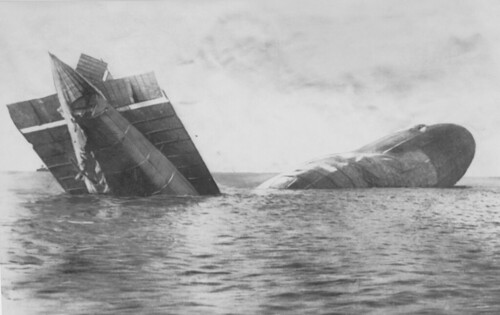
Zeppelin L 15 in the Thames, 1916.
A hundred years ago tonight, the night of October 13/14, 1915, was the deadliest German air raid on Britain of the First World War. In what became known as the “Theatreland Raid,” five German Navy Zeppelins arrived over the Norfolk coast at about 6:30 PM. Unbeknownst to the Germans, new ground defenses had been put in place, but the British guns proved ineffective. One of the guns, near Broxbourne, was put out of action by bombs dropped from Zeppein L 15. The airship continued to London and began bombing over Charing Cross. The first bombs struck the Lyceum Theatre, killing 17. Additional bombs were dropped on Holborn. As it approached Moorgate, it encountered a new 75 millimeter gun. Recognizing the threat, the airship quickly jettisoned ballast and dropped only three more bombs before fleeing.
In total, the five German airships killed 71 and injured 128 that night. Among those killed were three brothers, ages 10, 14, and 15. Roy, Brien, and Gorden Currie were sleeping when a bomb fell on their building.
When the fire brigade reached the boys’ room, Brien, the youngest, was already dead. Roy, the middle boy, was dead on arrival at the hospital. Gorden, the eldest, was severely wounded with wounds to the back, chest, hip, and thigh. A piece of shrapnel was in his body. He died of his wounds two days later.
At the coroner’s inquest, the Currie family’s housekeeper gave this account of the deadly attack:
I was fast asleep when I heard an awful explosion which awoke me. I seemed to spring from the top of the bed to the bottom. Then I groped my way to the door which I found was on the floor. I stayed there because the side wall had fallen in on the stairs and landing. I called out to the father asking if he was all right. He replied, “I’m all right, but I can’t move.” Then next I called for the boys, only the elder one answered. He said, “do get help.” I shouted to the lady next door. The wall was out and I could see into her house. I said, “our staircase is cut off, will you get help?”
The commander of Zeppelin L 15, which was probably the ship responsible for killing the boys, later described the mission in very different terms from his perspective at 9000 feet:
We then steered over Hyde Park, in the direction of the City. The picture we saw was indescribably beautiful–shrapnel bursting all around, our own bombs bursting and the flashes from the anti-aircraft batteries below. We flew over the City at between 9,000 and 9,800 feet and dropped twenty 110-pound bombs, and all the incendiary bombs. We could see large explosions between Charing Cross Station and the Bank of England.
The next year, this craft met its demise when it was taken down in the Thames estuary on April 1, 1916, shown in the picture above. One crewman was killed and the other 17 taken prisoner.
The German Zeppelin raids probably didn’t have the intended effect of terrorizing the populace into surrender. German Chancellor Theobald von Bethmann-Hollweig warned General Paul von Hindenburg that the anger of the English public over the raids had reached such a pitch that a negotiated peace between the two countries would be impossible. This assessment was probably correct. The Times of London opined after one raid, “if it were possible for the enemy to increase the utter and almost universal detestation in which he is held by the people of this country, he did it yesterday.”
In fact, one British army recruitment poster took advantage of the outrage by showing the image of a Zeppelin over a British city with the admonition, “it is far better to face the bullets than to be killed at home by a bomb. Join the army at once and help to stop an air raid.”
This BBC video contains the recollections of a survivor of a different attack, which took place in 1917. That attack took the lives of eighteen five-year-old students. This survivor was six years old and sitting at his desk at the time of the attack.
Read More at Amazon
References
Click Here For Today’s Ripley’s Believe It Or Not Cartoon
![]()
Welcome to OneTubeRadio.com. This blog covers a variety of subjects, including radio history, Minnesota history, World War I, World War II, and scouting.
Today, we offer these images of the Minnesota State Fair as it appeared a hundred years ago in 1915. The scene above is the bandstand. Visible in the background is the dome of the Agriculture Building. A closer images of this building is also shown here, from the fair’s 1915 annual report.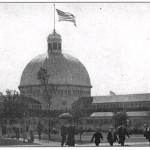
The grandstand, in the 1915 postcard shown below, is immediately recognizable to a modern visitor. As previously reported here, in 1922, the grandstand served as the wedding venue of Edwin Moline and Zelma Olson, who were married aboard an airplane flying above the grandstand. The presiding minister, Rev. E.A. Jordan, at 220 pounds, was too heavy to fit inside the airplane along with the pilot, bride, and groom. Therefore, he officiated from a pagoda within the grandstand, receiving the couple’s vows by a radio which was carried aboard the plane.
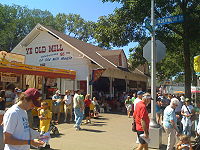
Ye Old Mill, 2008. Photo, placeography.org, Licensed under the Creative Commons
Attribution-ShareAlike License v. 3.0.
This year, the “Ye Old Mill” attraction at the Minnesota State Fair celebrates its 100th Anniversary. Many visitors are surprised to learn the nearly identical attractions with the same name at the Iowa State Fair (dating to 1921) and Kansas State Fair (also dating to 1915).
Radio has a long tradition at the Minnesota State Fair. Indeed, the photo of the grandstand shows on the field what certainly appears to be a wireless antenna of some sort, although I don’t have any details of the old image. In 1914, the fair’s governing board considered a proposition made by one Philip Edelman of St. Paul for the installation of a wireless station at an esimated cost of $200. The board decided to continue discussions with Edelman as to whether such an exhibit could be made in a future year at less cost.
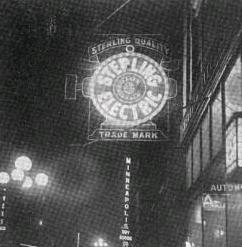
The Minneapolis sign of Sterling Electric Company, 1920 state fair exhibitor. Google books.
One of the earliest references I could find to radio at the State Fair was the December 1920 issue of Electrical Contractor Dealer, which detailed the experiences of the Sterling Electric Company of Minneapolis. At the 1920 Fair, the company had a large booth in the Electrical Building which included a wireless station that sent and received messages daily. The company followed up with a Saturday morning class in wireless telegraphy, in which there was considerable interest.
Shortly thereafter, the company, along with the Journal Printing Company, was the licensee of one of the area’s first broadcast stations, WBAD. That license was issued on April 25, 1922, according to the May 1922 issue of Radio World. It is likely, therefore, that the honors for being the first radio station at the fair go to WBAD. Since then, of course, local broadcasters have a long history of broadcasting from the fair. The image below from a WCCO promotional item shows the station’s then location in the Agriculture-Horticulture building.
Click Here For Today’s Ripley’s Believe It Or Not Cartoon ![]()
The unusual aircraft shown here first flew 50 years ago today, August 31, 1965.
It is tail number N940NS (formerly N1038V), the first of seven Aero Spacelines Super Guppy aircraft. It was built from the fuselage of a C-97J Turbo Stratocruiser, the military version of the Boeing 377 Stratocruiser. The fuselage had a length of 141 feet, with a maximum load of 52,500 pounds.
Today, six of the seven planes are mothballed or in static displays. A single one is still in service, with tail number N941NA. It is used by NASA as a transport aircraft and is based in El Paso, Texas. It was acquired by NASA from the European Space Agency, where it bore tail number F-GEAI.
Click Here For Today’s Ripley’s Believe It Or Not Cartoon ![]()
In part 3 of this series, we looked at some of the remarkable distances covered by the Japanese Fu-Go fire balloons of World War II. Some of these balloons were found far inland in North America, including balloons found in Iowa, South Dakota, Manitoba, and Michigan. There’s no record of any of these balloons making it to Minnesota (although there’s the possibility that somewhere in Minnesota lies the rusting wreckage of one). But one of them played an interesting role in Minnesota postwar aviation.
As we covered in part 3, one of the balloons landed near Grand Rapids, Michigan. It was largely intact, and quickly whisked away by the FBI. It ultimately found its way to Lakehurst Naval Air Station in New Jersey, where it remained until the end of the war. In 1946, a young sailor named Don Piccard was stationed there, and was tasked with taking the craft to the dump. (The balloon was labeled as having come from Flint, Michigan, but it’s believed that it was actually the Grand Rapids balloon.)
Lakehurst is famous for lighter-than-air flying, and Piccard was undoubtedly stationed there for a reason. His family had long been active in ligher-than-air flight. His father was Swiss-born Jean Felix Piccard, then a professor of aeronautical engineering at the University of Minnesota. His mother was Jeanette Piccard. Jean Felix and Jeanette in 1933 had piloted a balloon 57,579 feet into the stratosphere. This constituted the world record altitude for flight by a woman, a record held for 29 years until Valentina Tereshkova became the first woman in space. If Wikipedia is to believed, Gene Roddenberry named the character Jean-Luc Picard after Jean Felix Piccard or his brother Auguste, another aviation pioneer. In fact, Jean-Luc is supposed to be a descendant of one of the men.
(Jeanette also became, in 1974, the first woman ordained as an Episcopal priest. At the age of 11, in response to the question of what she wanted to be when she grew up, she answered “a priest.” Her mother reportedly ran out of the room in tears. But after her long career in aviation, at the age of 79, she was ordained as one of the “Philadelphia Eleven.”)
Rather than taking the balloon to the dump as directed, the younger Piccard obtained a property pass to keep possession of the war trophy. Upon his discharge, he became a student at the University of Minnesota where his father taught. And he set out figuring out how to fly the balloon.
The Civil Aviation Agency had, at that time, the category of free balloon pilot, but no such license had been issued. A license for an airship pilot carried privileges for free balloons, and Piccard had accomplished most of his flight requirements in balloons with airship pilots. But he had not yet soloed, and he saw the war souvenir as an opportunity to do just that.
While the balloon was apparently in relatively good condition, it did have tears and was in need of repair. A glue adequate to do the job had to be procured. In addition, he needed funds to purchase the hydrogen, as well as kiln-dried sand to serve as ballast. (Sand with moisture would freeze, making for a lethal projectile when dropped.)
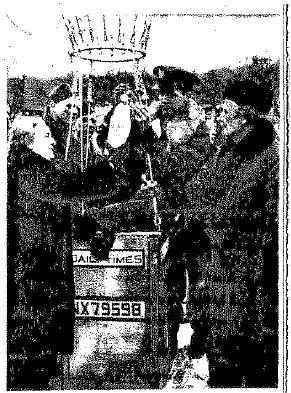
Piccard preparing for the 1947 flight. Image courtesy of Michigan Aviation Archaelogy.
To get the necessary funding, he sought the sponsorship of the Minneapolis Daily Times, which was granted, and the craft bore the paper’s name, above its N number, NX79598. Piccard was also a member of the Army Air Corps ROTC, which became the U.S. Air Force days before the flight. It was also sponsored by the ROTC, and Piccard wore a hastily assembled U.S. Air Force uniform during the flight. He later recounted that not only was his the first U.S. Air Force flight to take place in Minnesota, but also that his was quite possibly the first U.S. Air Force uniform ever worn.
The flight took place on February 16, 1947, from Minneapolis to White Bear Lake. After launch, apparently from South Minneapolis, Piccard had to maintain his altitude by venting the balloon and dropping ballast. He had originally intended to climb to the calculated maximum altitude of 12,000 feet and then begin his descent. But an overcast required him to control the altitude throughout the flight. The winds carried him to White Bear Lake, during which time Piccard had remained aloft for more than the two hours necessary to qualify for his solo flight, and he the CAA subsequently issued him the first ever free balloon pilot license. (This was the balloon’s last flight. Since Piccard didn’t have a bill of sale for the Japanese balloon, he was unable to register the craft.)
The flight received media attention nationwide, and also caused quite a commotion as it landed in White Bear Lake. Apparently, nobody had told the White Bear Lake Police Department that the flight was headed their way, and they were unprepared for the resulting commotion as hundreds of curiosity seekers flooded the area, trespassing on private property. At one point, the officers threatened to arrest the army personnel in the chase vehicle, who they determined must be responsible for the breach of the peace.
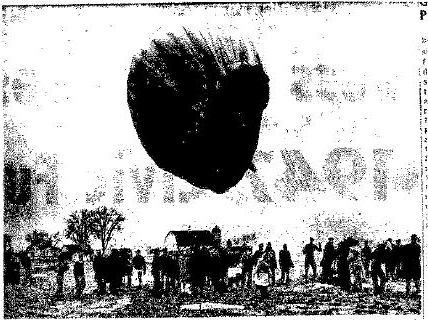
Scene of the landing in White Bear Lake. Image courtesy of Michigan Aviation Archaeology.
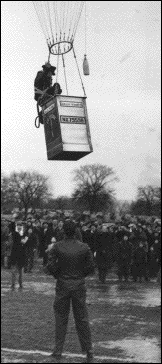
The last flight of a Fu-Go balloon. Image courtesy of Michigan Aviation Archaeology.
Since the Daily Times was actually an afternoon newspaper, the morning papers all managed to scoop the sponsor of the flight, although they didn’t refer to it in print as being the Daily Times Flight. Piccard later wrote a detailed account of his flight for Air & Space Smithsonian.
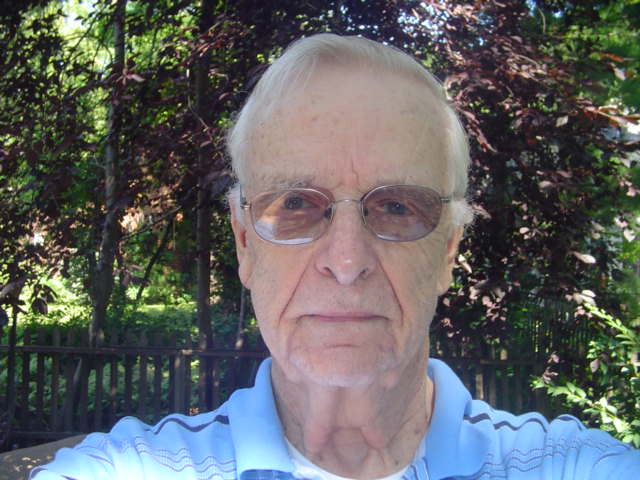
Don Piccard. Licensed under Public Domain via Wikimedia Commons.
Piccard is regarded as the driving force behind the sport of ballooning, and is still active with his company, Piccard Balloons. When I looked at Piccard’s personal web page, www.N6US.com, I mistakenly assumed that he was a ham. While the URL looks like an Amateur Radio call sign, it should be remembered that aircraft tail numbers (or whatever they’re called on balloons) also use the same international prefixes as radio call signs. In this case, N6US is not a radio call sign issued by the FCC, but an aircraft registered to Mr. Piccard.
In 2008, Piccard was inducted into the Minnesota Aviation Hall of Fame. (The other member of the Minnesota Aviation Hall of Fame who has been mentioned in this blog was Sherman Booen, about whom we wrote in connection with the 1940 Armistice Day Blizzard.)
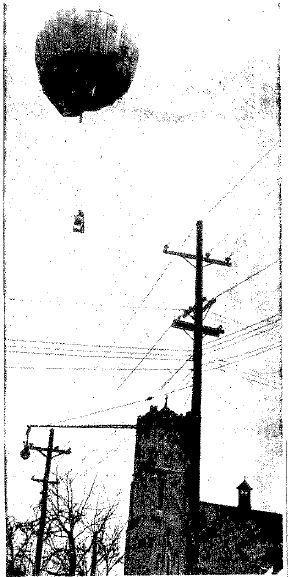
The balloon after launch. Image courtesy of Michigan Aviation Archaeology.

Image courtesy of Michigan Aviation Archaeology.
Acknowledgement
I would like to thank Jeffrey Benya of Michigan Aviation Archaelogy for giving permission to use the images of the newspaper clippings shown here.
References
Read More at Amazon
Click Here For Today’s Ripley’s Believe It Or Not Cartoon ![]()
 Seventy five years ago, Scout Felton Fineannon of Troop 26, Miami, assists 19-year-old Miss Ruth Shelley as she hoists Old Glory to mark the opening of the All-American Air Maneouvers held in Miami. Miss Shelly had been named Miss Miami Aviation in a beauty contest in which she took a challenge to earn her pilot license and learn to fly a sea plane solo within a week.
Seventy five years ago, Scout Felton Fineannon of Troop 26, Miami, assists 19-year-old Miss Ruth Shelley as she hoists Old Glory to mark the opening of the All-American Air Maneouvers held in Miami. Miss Shelly had been named Miss Miami Aviation in a beauty contest in which she took a challenge to earn her pilot license and learn to fly a sea plane solo within a week.
She held the title for two years, during which time her photo frequently appeared in the papers. Years later, a schoolmate wrote to her and told her that one of those newspaper clippings kept him alive during World War II. In a letter written to her a half century later, he told her that the picture kept his faith alive during the darkest moments of the war. She died Mrs. Ruth Chenoweth in 2009 at the age of 89.
Referernces
Click Here For Today’s Ripley’s Believe It Or Not Cartoon
![]()
Seventy years ago, the U.S. conducted its most destructive air raid of the Second World War. On the night of March 9-10, 279 American B-29s operating from Guam, Tinian, and Saipan dropped 1,665 tons of bombs on Tokyo. Fourteen of the planes were lost, but the incendiary bombs created a general conflagration that overwhelmed the city’s fire defenses and destoyed 16 square miles of the city. Over 100,000 were killed in the raid, and over a million Tokyo residents lost their homes.
References
Ninety years ago today, the March 7, 1925, issue of Radio Digest carried this photo of an airplane used by WCCO radio in Minneapolis to carry “the only successful airplane broadcast of the recent solar eclipse.”
The plane was equipped with the 5-watt transmitter shown here.
The eclipse, which took place on January 24, 1925, had been visible in Northern Minnesota, and then moved over the Northeastern United States and then the North Atlantic. Its shadow had passed over Manhattan, where the path of totality was above 96th Street. Those below 96th street experience only a partial eclipse.
The film below shows film of the eclipse as seen from a Navy dirigible.
As I reported in an earlier post, the station had recently adopted the WCCO call sign, having previously been known as WLAG. Another photo of the event can be found in WCCO’s 40th Anniversary album.
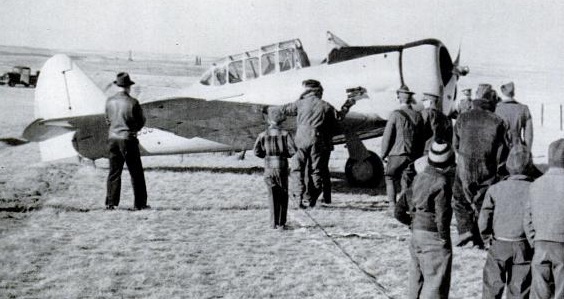 Life Magazine 75 years ago, December 11, 1939, shows this photo of an aircraft being exported from the United States en route to its new owner, the British Royal Air Force. American neutrality prevented either American or Canadian pilots from flying military aircraft across the border. To remedy this difficulty, the planes were flown from the factory in California to Sweetgrass, Montana. From the airstrip near the border, the planes were towed by automobile over the border. The line running up the picture is the international boundary. The plane’s nose is in Canada, and its tail is in the United States.
Life Magazine 75 years ago, December 11, 1939, shows this photo of an aircraft being exported from the United States en route to its new owner, the British Royal Air Force. American neutrality prevented either American or Canadian pilots from flying military aircraft across the border. To remedy this difficulty, the planes were flown from the factory in California to Sweetgrass, Montana. From the airstrip near the border, the planes were towed by automobile over the border. The line running up the picture is the international boundary. The plane’s nose is in Canada, and its tail is in the United States.
The airport in question is truly an international airport. Coutts/Ross Sweetgrass International Airport‘s current runway, 07-26, is a 2900 foot grass strip that runs East-West along the international border. It can currently be used to clear customs entering either the United States or Canada.
Click Here For Today’s Ripley’s Believe It Or Not Cartoon
![]()